

 is considerably over forty years
since I first became interested in the problem of flight. This
presented the attraction of an unsolved problem which did not
seem as visionary as that of perpetual motion. Birds gave daily
proof that flying could be done, and the reasons advanced by scientists
why the performance was inaccessible to man did not seem to be
entirely conclusive, if sufficiently light motors were eventually
to be obtained. There was, to be sure, a record of several thousand
years of constant failures, often resulting in personal injuries;
but it did not seem useless for engineers to investigate the causes
of such failures, with a view to a remedy. I, therefore, gathered
from time to time such information as was to be found on the subject,
and added thereto such speculations as suggested themselves. After
a while this grew absorbing, and interfered with regular duties,
so that in 1874 all the accumulated material was rolled up into
a bundle and red tape tied around it, a resolution being taken
that it should not be undone until the subject could be taken
up again without detriment to any duty. It was fourteen years
before the knot was untied.
is considerably over forty years
since I first became interested in the problem of flight. This
presented the attraction of an unsolved problem which did not
seem as visionary as that of perpetual motion. Birds gave daily
proof that flying could be done, and the reasons advanced by scientists
why the performance was inaccessible to man did not seem to be
entirely conclusive, if sufficiently light motors were eventually
to be obtained. There was, to be sure, a record of several thousand
years of constant failures, often resulting in personal injuries;
but it did not seem useless for engineers to investigate the causes
of such failures, with a view to a remedy. I, therefore, gathered
from time to time such information as was to be found on the subject,
and added thereto such speculations as suggested themselves. After
a while this grew absorbing, and interfered with regular duties,
so that in 1874 all the accumulated material was rolled up into
a bundle and red tape tied around it, a resolution being taken
that it should not be undone until the subject could be taken
up again without detriment to any duty. It was fourteen years
before the knot was untied.
Meantime a considerable change had taken place in the public attitude on the question. It was no longer considered proof of lunacy to investigate it, and great progress had been made in producing artificial motors approximating those of the birds in relative lightness. The problem was, therefore, taken up again under more favorable circumstances. A study was begun of the history of past failures, and the endeavor was made to account for them. In point of fact, this produced a series of technical articles which swelled into a book,1 and also led to the conclusion that, when a sufficiently light motor was evolved, the principal cause of failure would be that lack of stability in the air which rendered all man-ridden flying-machines most hazardous, but that, if this difficulty were overcome, further progress would be rapid.
Experiments were, therefore, begun to investigate this question of stability and safety, and, if possible, to render the former automatic. These experiments were hundreds in number, and were at first, very modest. They consisted in liberating weighted paper models of various shapes, either ancient or new, with gravity as a motive power, and observing their glides downward. This was done in still air. After a while, resort was had to larger models, with muslin wings and wooden frameworks, carrying bricks as passengers; and these were dropped from the house-top in the early morning when only the milkman was about. Very much was learned as to the effect of the wind; and then tailless kites of all sorts of shapes were flown, to the great admiration of small boys. During the seven or eight years within which this work was carried on, some glimmerings were obtained of the principles involved, and some definite conclusions were reached. But it was only after Lilienthal had shown that such an adventure was feasible that courage was gathered to experiment with full-sized machines carrying a man through the air.
Otto Lilienthal was a very able German engineer and physicist. He demonstrated that concave wings afforded, at very acute angles, from three to seven times as much support as flat wings in the air. He made, from 1891 to 1896, more than 2,000 successful glides, the longest being about 1,200 feet, upon machines of his own design launching himself into the air from a hilltop and gliding down against the wind. In 1895, he endeavored to add a motor, but found that this complicated the handling so much that he went back to his gliding-device. It was while experimenting with a double-decked machine of this character, which probably was in bad order, that he fell and was killed, in August, 1896. Thus perished the man who will probably be credited by posterity with having pointed out the best way to preliminary experiments in human flight through the air.
Just before this dismal accident, I had been testing a full-sized Lilienthal machine. I discarded it as hazardous, and then tested the value of an idea of my own. This was to follow the same general method, but to reverse the principle upon which Lilienthal had depended for maintaining his equilibrium in the air. He shifted the weight of his body, under immovable wings, as fast and as far as the sustaining pressure varied under his surfaces. This shifting was mainly done by moving the feet, as the actions required were small except when alighting. My notion was to have the operator remain seated in the machine in the air, and to intervene only to steer or to alight; moving mechanism being provided to shift the wings automatically, so as to restore the balance when endangered. There are several ways in which this can be done. Two of them have been worked out to a probable success in my experiments, and there is still a third which I intend to test in due course.
To make such experiments truly instructive, they should be made with a full-sized machine and with an operator riding therein. Models seldom fly twice alike in the open air (where there is almost always some wind), and they cannot relate the vicissitudes which they have encountered. A flying-machine would be of little future use if it could not operate in a moderate wind; hence the necessity for an operator to report upon what occurs in flight, and to acquire the art of the birds. My own operations were conducted from That point of view, with the great disadvantage, however, that being over threescore years of age, I was no longer sufficiently young and active to perform any but short and insignificant glides in such tentative experiments; the latter being directed solely to evolving the conditions of stability, and without any expectation of advancing to the invention of a commercial flying-machine. I simply tested various automatic devices to secure equilibrium, and, with great anxiety, employed young and active assistants.
The best way to carry on such adventures is first to select a soft place on which to alight. This is well secured on a dry and loose sand-hill], and there ought to be no bushes or trees to run into. Our party found such sand-hills, almost a desert, in which we pitched our tent, on the shore of Lake Michigan, about thirty miles east of Chicago. The main hill selected was ninety-five feet high; but the highest point started from was sixty-one feet above the beach, as the best instruction was to be obtained from short glides at low speeds.
With parties of from four to six persons five full-sized gliding-machines2 (one rebuilt) were experimented with in 1896, and one in 1897. Out of these, two types were evolved, the " Multiple-Wing" and the " Two-Surfaced," which are believed to be safer than any heretofore produced, and to work out fairly well the problem of automatic equilibrium. The photographs herewith reproduced, many of them heretofore unpublished, are from snap-shots taken of these two types. In 1896, very few photographs were taken; all the attention being devoted to studying the action of the machines, and the one picture shown is the sixth permutation of the " Multiple-Wing " machine, so-called. In 1897, there was more leisure to take snapshots, as the machine used was a duplication of the " Two-Surfaced" of 1896, supplied with a regulating mechanism designed by Mr. A. M. Herring, my assistant. Each photograph was taken from a different experiment (there were about 1,000 glides); but the point of view was varied, so as to exhibit the consecutive phases of a single flight. The frog-like appearance of some of the legs is due to the speed.
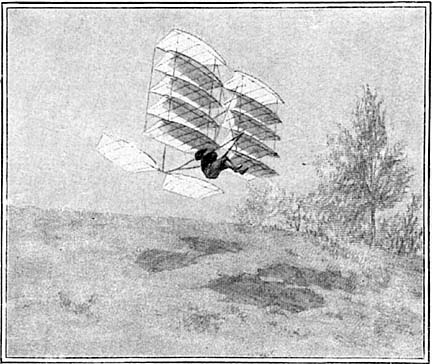
MR. CHANUTE'S MULTIPLE-WING GLIDING-MACHINE.
The first thing which we discovered practically was that the wind flowing up a hillside is not a steadily flowing current like that of a river. It comes as a rolling mass, full of tumultuous whirls and eddies, like those issuing from a chimney; and they strike the apparatus with constantly varying force and direction, sometimes withdrawing support when most needed. It has long been known, through instrumental observations, that the wind is constantly changing in force and direction; but it needed the experience of an operator afloat on a gliding machine to realize that this all proceeded from cyclonic action; so that more was learned in this respect in a week than had previously been acquired by several years of experiments with models. There was a pair of eagles, living in the top of a dead tree about two miles from our tent, that came almost daily to show us how such wind effects are overcome and utilized. The birds swept in circles overhead on pulseless wings, and rose high up in air. Occasionally there was a side-rocking motion, as of a ship rolling at sea, and then the birds rocked back to an even keel; but although we thought the action was clearly automatic, and were willing to learn, our teachers were too far off to show us just how it was done, and we had to experiment for ourselves.
The operator stands on the hill-side. He raises up the apparatus, which is steadied by a companion, and quickly slips under and within the machine. He faces the wind. This wind buffets the wings from side to side, and up or down, so that he has much difficulty in obtaining a poise. This is finally accomplished by bracing the cross-piece of the machine's frame against his back, and depressing the front edge of the wings so that they will be struck from above by the wind. His arm-pits rest on a pair of horizontal bars, and he grasps a pair of vertical bars with his hands. He is in no way attached to the machine, so that he may disengage himself instantly should anything go wrong. Then, still facing dead into the wind, he takes one or two never more than four, running steps forward, raising up the front edge of the apparatus at the last moment, and the air claims him. Then he sails forward into the wind on a generally descending course. The " Multiple-wing " machine was provided with a seat, but, goodness ! there was no time to sit down, as each glide of two to three hundred feet took but eight to twelve seconds, and then it was time to alight. This latter phase of the problem had been the subject of meditation for months, and the conclusion had been reached to imitate the sparrow. When the latter approaches the street, he throws his body back, tilts his outspread wings nearly square to the course, and on the cushion of air thus encountered he stops his speed and drops lightly to the ground. So do all birds. We tried it with misgivings, but found it perfectly effective. The soft sand was a great advantage, and even when the experts were racing there was not a single sprained ankle.
The rebuilt "Multiple-wings " were pivoted at their roots, and vibrated backward and forward on ball-bearings, restrained by rubber springs. As the wind varied, they adjusted themselves thereto, and brought back the supporting air pressure over the operator, thus reestablishing the threatened balance. This was done automatically. But in consequence of various defects in construction and adjustment, the operator still had to move one or two inches, as against the from seven to fifteen inches of movement required by the Lilienthal apparatus. Some two or three hundred glides were made with the "Multiple-wing " with-out any accident to man or machine, and the action was deemed so effective, the principle so sound, that the full plans were published in the " Aeronautical Annual " for 1897, for the benefit of experimenters desiring to improve on this apparatus.
There is no more delightful sensation than that of gliding through the air. All the faculties are on the alert, and the motion is astonishingly smooth and elastic. The machine responds instantly to the slightest movement of the operator; the air rushes by one's ears; the trees and bushes flit away underneath, and the landing comes all too quickly. Skating, sliding, and bicycling are not to be compared for a moment to aerial conveyance, in which, perhaps, zest is added by the spice of danger. For it must be distinctly understood that there is constant danger in such preliminary experiments. When this hazard has been eliminated by further evolution, gliding will become a most popular sport.
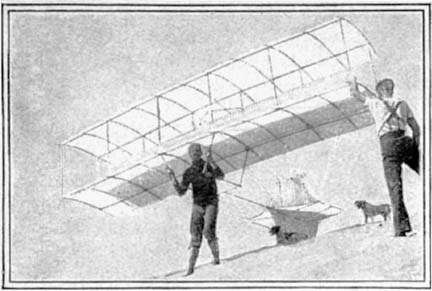
Struggling for a poise.
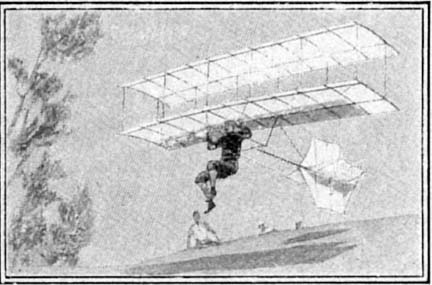
A good start.
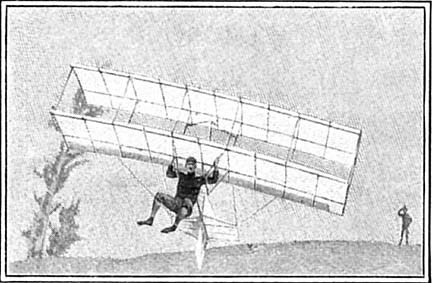
Struck by a side gust.
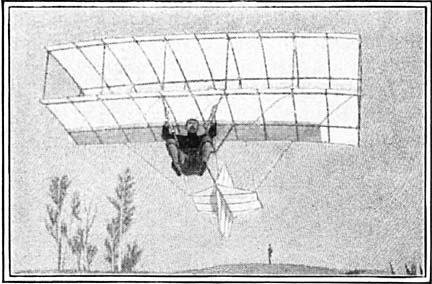
Right again.
EXPERIMENTS WITH MACHINES INVENTED BY MR. CHANUTE. FROM PHOTOGRAPHS TAKEN BY HIM.
The "Two-surfaced" machine, so-called, produced longer and more numerous glides. There were perhaps 700 or 800, at a rate of descent of about one foot in six; so that while the longest distance traversed was 360 feet, we could have sailed 1,200 feet, had we started from a hill 200 feet high. In consequence of the speed gained by running, the initial stage of the flight is nearly horizontal, and it is thrilling to see the operator pass from thirty to forty feet overhead, steering his machine, undulating his course and struggling with the wind gusts which whistle through the guy wires. The automatic mechanism restores the angle of advance when compromised by variations of the breeze ;- but when these come from one side and tilt the apparatus, the weight has to be shifted to right up the machine. This is generally done by thrusting out the feet toward the side which has been raised, a movement which is just the reverse of what would be instinctively made on the ground, but which becomes second nature to an expert. These gusts sometimes raise the machine from ten to twenty feet vertically, and sometimes they strike the apparatus from above, causing it to descend suddenly. When sailing near the ground, these vicissitudes can be counteracted by movements of the body of three or four inches; but this has to be done instantly, for neither wind nor gravity will wait on meditation. At a height of 300 or 400 feet the regulating mechanism would probably take care of these wind gusts, as it does, in fact, for their minor variations. The speed of the machine is generally about seventeen miles an hour over the ground, and from twenty-two to thirty miles an hour relative to the air. Constant effort was directed to keep down the velocity, which was at times fifty-two miles an hour. This is the purpose of the starting and gliding against the wind, which thus furnishes an initial velocity without there being undue speed at the landing. The highest wind we dared to experiment in blew at thirty-one miles an hour; when the wind was stronger, we waited and watched the birds.
There was a gull came fishing over the lake, and took up his station over its very edge, about 100 feet high in air. The wind was blowing a steady gale from the north at sixty-one measured miles an hour. The bird breasted it squarely, and without beat of wing maintained for five minutes his position of observation. Occasionally there was a short rocking motion fore and aft, or from side to side. At times he was raised several feet and drifted backward; at others he drooped down; but he never flapped once. It was evident that he derived from the wind alone all the power required to remain afloat and to perforate the blast without drifting back. Whether man will ever be able to perform this feat, which has been termed " aspiration," is perhaps doubtful, but there is no mistake about the observation. The only thing we could not ascertain was whether our practice hill, 350 feet to his leeward, produced an ascending trend in the wind about the bird, who was level with its summit.
Another day a curious thing occurred. We had taken one of the machines to the top of the hill, and loaded its lower wings with sand to hold it while we went to lunch. A gull came strolling inland, and flapped full-winged to inspect. He swept several circles above the machine, stretched his neck, gave a squawk, and went off. Presently he returned with eleven other gulls, and they seemed to hold a conclave, about 100 feet above the big new white bird which they had discovered on the sand. They circled round after round, and once in a while there was a series of loud peeps, like those of a rusty gate, as if in conference, with sudden flutterings, as if a terrifying suggestion had bean made. The bolder birds occasionally swooped downward to inspect the monster more closely; they twisted their heads around to bring first one eye and then the other to bear, and then they rose again. After some seven or eight minutes of this performance, they evidently concluded either that the stranger was too formidable to tackle, if alive, or that he was not good to eat, if dead, and they flew off to resume fishing, for the weak point about a bird is his stomach.
We did not have the slightest accident to lament during all our experiments. These were chiefly performed by two young, active men, who took turns, and who became expert in a week; but then, we attempted no feats and took no chances. Toward the last, we gained such confidence in the machines that we allowed amateurs to try them under guidance. Half a dozen performed fairly well, but awkwardly of course. One of them was our cook, who was by profession a surgeon, and one was a newspaper reporter who had succeeded in finding his way to the camp. Another was a novice; he was picked up by a wind gust, raised forty feet vertically, and gently set down again. Any young, quick and handy man can master a gliding-machine almost as soon as a bicycle, but the penalties for mistakes are much more severe. After all, it will be by the cautious, observant manóthe man who accepts no risks which he can avoid, perhaps the ultra-timid manó that this hazardous investigation of an art now known only to the birds will be most advanced. Not even the birds could have operated more safely than we, but they would have made longer and flatter glides, and they would have soared up into the blue.
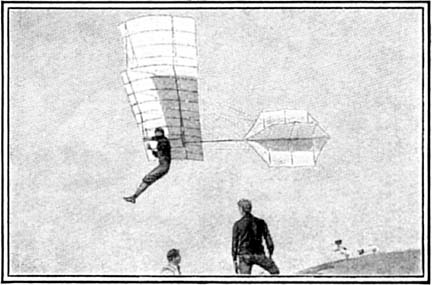
Rising
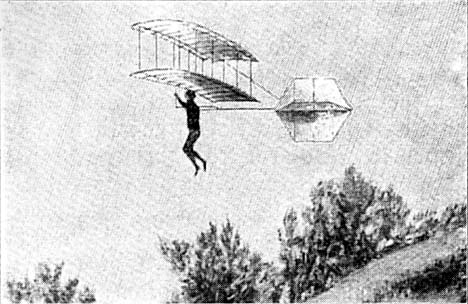
Sailing
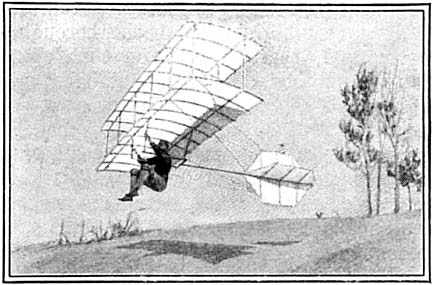
Dropping
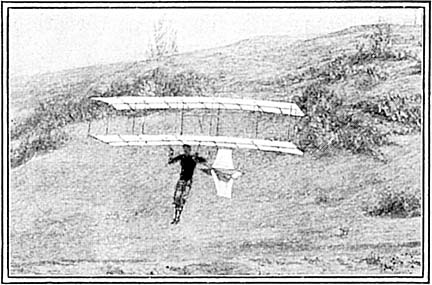
About to alight
EXPERIMENTS WITH MACHINES INVENTED BY MR. CHANUTE. FROM PHOTOGRAPHS TAKEN BY HIM.
In my judgment, neither of the machines above described is as yet perfected, and I believe it is still premature to apply an artificial motor. This is sure to bring about complications which it is preferable to avoid until the equilibrium has been thoroughly evolved. I, therefore, advise that every plausible method of securing stability and safety shall he tested, that many such experiments shall be made, first with models, and then with full-sized machines, and that their designers shall practice, practice, practice; to make sure of the action, to proportion and adjust the parts, and to eliminate hidden defects. If any feat is attempted, it should be over water, in order to break the fall, should any occur. All this once accomplished, it will be time enough to apply a motor; and it seems not improbable that the gliding-machine will furnish the prototype. This step-by-step process is doubtless slow and costly, but it greatly diminishes the chance of those accidents which bring a whole line of investigation into contempt. We have no reason to believe that, contrary to past experience, a practical flying-machine will be the result of the happy thought of one or of two persons. It will come rather by a process of evolution one man accomplishing some promising results, but stopping short of success; the next carrying the investigation somewhat further, and thus on, until a machine is produced which will be as practical as the " safety " bicycle, which took some eighty years for its development from the original despised velocipede.
Since the above described experiments were tried, another deplorable accident has come to re-inculcate the necessity for extreme caution. Mr. Percy S. Pilcher, a young, accomplished, and enthusiastic English engineer, lost his life September 30, 1899, while making experiments in soaring with a machine of his own design upon the Lilienthal principle. He had already performed hundreds of glides since 1894, and had introduced a method of towing the machine with horses, by means of a long cord with multiplying tackle, so that he could rise from level ground. On this occasion, a first successful flight was made; but on the second trial, after a height of some thirty feet had been gained, a snap was heard, the tail was seen to collapse, and the apparatus dived forward, and fell to the ground, Mr. Pilcher receiving injuries from which he died two days later. He doubtless was the victim of his own amiability, for his apparatus had been wet by a shower, so that the canvas of the tail had shrunk, thus producing undue strains upon the bamboo stretcher, the wind was gusty, and the weather very unfavorable; but as many persons had come from a distance to witness the experiments, Mr. Pilcher did not like to disappoint them, and accepted the undue risks which cost him his life. He was less than thirty-four years of age, a skilful and earnest mechanician, who had already built the oil-engine and screw which he meant to apply to his machine.

Preparing for the flight.
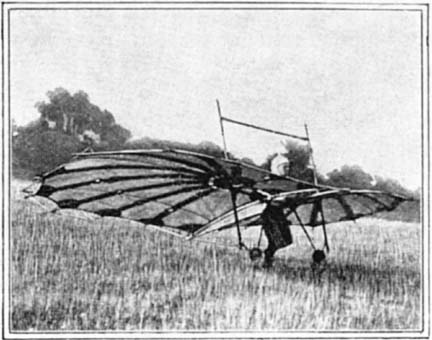
Ready.
THE PILCHER FLYING-MACHINE.
Notably enough, he had written to me some eighteen months before for leave to copy and test one of my machines, which leave, with instructions, had, of course, been gladly given. The machine had been built, and was to have been tried on the following day. It is a curious coincidence that Lilienthal is said to have also built a machine quite original with him, upon the same principle as that above alluded to, and that this also was to have been tested within a day or two of the owner's death. It is idle to speculate on what would have been the result; but then accidents might have happened in my own work, and I am profoundly thankful that we were spared such anguish.

Sailing

Dropping and going fast.
THE PILCHER FLYING-MACHINE.
Having been compelled, for the last two years, to give all my time and attention to a practical business, I have been unable to experiment; but I have had an expert testing models of a third method of securing automatic stability, which I hope to experiment full-sized.
Aside from the more imaginative and eccentric inventors, there are now a number of scientific investigators who are working to bring about the solution of this difficult problem; and it is not at all improbable that some experimenter will succeed, within a year or so, in making a flight of something like a mile with a motor. This is now fairly feasible, and there are several inventors who are preparing to attempt it. But between this achievement and its extension to a journey, or even to its indefinite repetition, there will intervene many accidents. Nor is there a fortune to be made by the first successful man.T Experimenters who wish to advance the final solution of the quest surely and safely must work without expectation of other reward than that of being remembered hereafter; for, in the usual course of such things, it will be the manufacturers who will reap the pecuniary benefits when commercial flying-machines are finally evolved. There will probably be two types of these, one of them a machine for sport, with a very light and simple motor, if any, carrying but a single operator, and deriving most of its power from wind and gravity, as do the soaring birds. This will be used in competitions of skill and speed, and there will be no finer or more exciting sport. The other future machine will probably be of a journeying type. It will be provided with a powerful, but light, motor and with fuel for one or two days' travel. It will preferably carry but a single man, and will be utilized in exploration and in war. Its speed will be from thirty to sixty miles an hour at the beginning, and eventually much greater, for it is a singular fact that the higher speeds require less power in the air, within certain limits, than low speeds. At high velocities, the surfaces may be smaller, lie at flatter angles, and offer less resistance, but the pressure then increases on the framework, and the ultimate speed may not be more than 8O or 100 miles an hour.
Neither of these machines seems likely to compete with existing modes of transportation. But be this as it may, every improvement in transportation, whether in cheapness, in comfort, or in speed, soon develops new and sometimes unexpected uses of its own; so, even with sober anticipation of the benefits to be realized, investigators and public-spirited men may well afford to advance the solution of a problem which has so warmly appealed to the imagination of men for the past forty or fifty centuries.
1 " Progress in Flying-Machines," 1894. M. N. Forney, New York, publisher.
2 So termed to distinguish them from true flying-machines in which propulsion would be implied.
Originally appeared in McClure's Magazine, 15, June, 1900, pp. 127-133.
sbjw